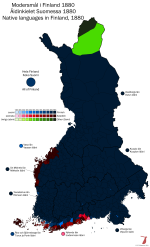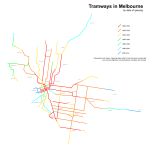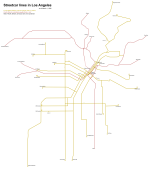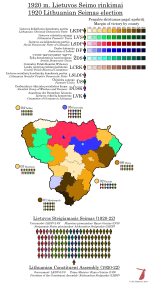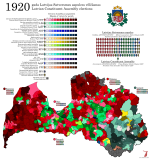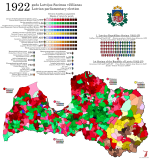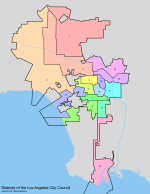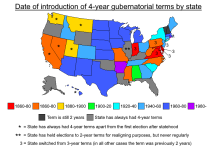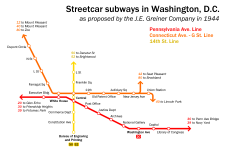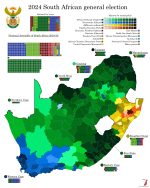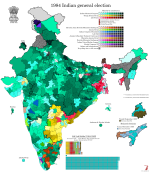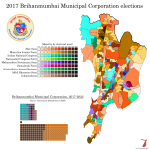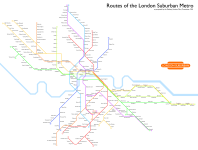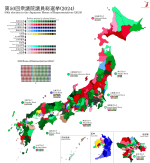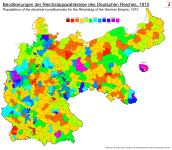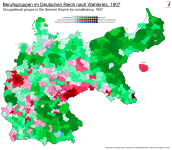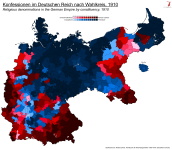Once again I've been waylaid by something that just kind of happened to be there.
Medieval Oslo had multiple churches, of which St. Hallvard's Cathedral was the most prominent, but after it burned down in 1624 (the city, that is - the cathedral was actually one of the few buildings to survive the fire), King Christian IV ordered it moved to a new location west of where it had been and modestly renamed it Christiania. The new city had a modern, right-angled street grid, a large military fortress at Akershus that doubled as the seat of government (kind of a kremlin, when you think about it), and a single large church at its single town square, which was named "Vor Frelser" ("Our Saviour" in Danish) as a reminder not to try any of that Papist nonsense around here.
Christiania remained a small city for the next two hundred years, populated largely by royal officials and their families, and so Vor Frelser was enough to fulfil the spiritual needs of the townspeople until 1858, when the city's land area was extended and it was determined that a second church was needed. Again, a suitably un-popish name was chosen for it, this time "Trefoldighed" ("Trinity"), and the city was split down the middle along Kongens gate, with Trefoldighed handling the west and Vor Frelser (which remained the seat of the Bishop of Oslo) the east. Trefoldighed took in some of the newly-annexed lands to the west, but in the north and east, a large area remained under Aker parish (the rural parish that surrounded Christiania) until arrangements could be made in 1861. The 1858 expansion had actually placed the old Aker church (Oslo's oldest building, dating back to the 12th century) within the city limits, and so the northern outskirts of the city were formed into the parish of "Gamle Aker" ("Old Aker") with the old church as its parish church. The eastern areas became the Grønland parish, simply named for the area the church was in, while the rural parish was split into a western and an eastern part, with each getting its own church.
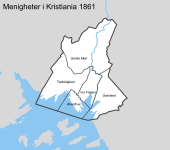
By this time, Christiania was becoming Norway's industrial capital as well as its administrative one, and its population very soon outstripped what these four parishes could handle. In 1874, every parish except Grønland was split in half, with the eastern part of Gamle Aker forming Paulus parish, the north of Vor Frelser becoming Jakob, and the south-east of Trefoldighed becoming Johannes. Apparently naming churches after the apostles was fine in a Protestant country now. O tempora, o mores.
In 1878, there followed a second expansion of the city limits, necessary because it was running out of land to build new housing on. Three new parishes were formed out of these annexed areas: Uranienborg in the west, Kampen in the east and Petrus in the northeast (making a nice companion to Paulus). Around the same time, both Gamle Aker and Grønland were split, with Grønland's southern part forming the new parish of Oslo (named after the medieval town once located on its territory) while the north of Gamle Aker combined with some of the newly-annexed land to form the parish of Sagene. Aside from Petrus, all of these were simply named after the geographic areas they covered, and this would continue to be the dominant pattern going forward.

In less than a decade, Christiania (now often spelled Kristiania, in a slightly "Norwegianised" form) had gone from four to twelve parishes. However, its population kept growing, and now it was the west that needed attention. Uranienborg, Gamle Aker and Trefoldighed were all quite large compared to their eastern neighbours, and while the west was also less densely populated (due to being much, much wealthier), the large parishes were still presenting administrative issues. In 1897, Trefoldighed parish lost territory on almost all sides, and Uranienborg was split in three, with the northern areas becoming Fagerborg parish and the south becoming Frogner. Two years later, Oslo and Kampen gave up territory to the new parish of Vaalerengen, which covered a working-class neighbourhood that had been unacceptably far from either church.
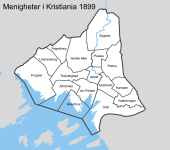
This was the state of things when Norway became an independent state in 1905, and continued unchanged until 1916, when they decided to do some weird shit. A total of six new parishes were created, mainly in working-class areas, and while a couple of them made sense (splitting Sagene was probably inevitable, since its church was west of the river while most of the population was east of it), some of the others were just a few blocks each, and it honestly surprises me that people ever thought they'd be viable.

1916, then, represents the peak concentration of parishes in the city, and from here on, at least for the city centre, parishes are going to get merged rather than split. The only 1916 creations with any real future were Markus, which was later expanded to cover all of Gamle Aker west of Ullevålsveien, and Torshov, which was far from the smallest parish in the city to begin with. By 1938, all four of the others had been suppressed, although some carried on as subunits of their new-old parishes. Johannes was also suppressed in 1926, and in 1938 the Akershus garrison church also lost its parish status, with the result that Vår Frelser (now respelled to fit the modern Bokmål standard) now covered the bulk of the city centre. And of course, in 1925, the city was renamed, taking back its pre-Danish name Oslo. To avoid confusion, the Oslo parish was rechristened "Gamlebyen" ("Old Town") at the same time.
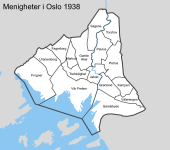
Medieval Oslo had multiple churches, of which St. Hallvard's Cathedral was the most prominent, but after it burned down in 1624 (the city, that is - the cathedral was actually one of the few buildings to survive the fire), King Christian IV ordered it moved to a new location west of where it had been and modestly renamed it Christiania. The new city had a modern, right-angled street grid, a large military fortress at Akershus that doubled as the seat of government (kind of a kremlin, when you think about it), and a single large church at its single town square, which was named "Vor Frelser" ("Our Saviour" in Danish) as a reminder not to try any of that Papist nonsense around here.
Christiania remained a small city for the next two hundred years, populated largely by royal officials and their families, and so Vor Frelser was enough to fulfil the spiritual needs of the townspeople until 1858, when the city's land area was extended and it was determined that a second church was needed. Again, a suitably un-popish name was chosen for it, this time "Trefoldighed" ("Trinity"), and the city was split down the middle along Kongens gate, with Trefoldighed handling the west and Vor Frelser (which remained the seat of the Bishop of Oslo) the east. Trefoldighed took in some of the newly-annexed lands to the west, but in the north and east, a large area remained under Aker parish (the rural parish that surrounded Christiania) until arrangements could be made in 1861. The 1858 expansion had actually placed the old Aker church (Oslo's oldest building, dating back to the 12th century) within the city limits, and so the northern outskirts of the city were formed into the parish of "Gamle Aker" ("Old Aker") with the old church as its parish church. The eastern areas became the Grønland parish, simply named for the area the church was in, while the rural parish was split into a western and an eastern part, with each getting its own church.

By this time, Christiania was becoming Norway's industrial capital as well as its administrative one, and its population very soon outstripped what these four parishes could handle. In 1874, every parish except Grønland was split in half, with the eastern part of Gamle Aker forming Paulus parish, the north of Vor Frelser becoming Jakob, and the south-east of Trefoldighed becoming Johannes. Apparently naming churches after the apostles was fine in a Protestant country now. O tempora, o mores.
In 1878, there followed a second expansion of the city limits, necessary because it was running out of land to build new housing on. Three new parishes were formed out of these annexed areas: Uranienborg in the west, Kampen in the east and Petrus in the northeast (making a nice companion to Paulus). Around the same time, both Gamle Aker and Grønland were split, with Grønland's southern part forming the new parish of Oslo (named after the medieval town once located on its territory) while the north of Gamle Aker combined with some of the newly-annexed land to form the parish of Sagene. Aside from Petrus, all of these were simply named after the geographic areas they covered, and this would continue to be the dominant pattern going forward.

In less than a decade, Christiania (now often spelled Kristiania, in a slightly "Norwegianised" form) had gone from four to twelve parishes. However, its population kept growing, and now it was the west that needed attention. Uranienborg, Gamle Aker and Trefoldighed were all quite large compared to their eastern neighbours, and while the west was also less densely populated (due to being much, much wealthier), the large parishes were still presenting administrative issues. In 1897, Trefoldighed parish lost territory on almost all sides, and Uranienborg was split in three, with the northern areas becoming Fagerborg parish and the south becoming Frogner. Two years later, Oslo and Kampen gave up territory to the new parish of Vaalerengen, which covered a working-class neighbourhood that had been unacceptably far from either church.

This was the state of things when Norway became an independent state in 1905, and continued unchanged until 1916, when they decided to do some weird shit. A total of six new parishes were created, mainly in working-class areas, and while a couple of them made sense (splitting Sagene was probably inevitable, since its church was west of the river while most of the population was east of it), some of the others were just a few blocks each, and it honestly surprises me that people ever thought they'd be viable.

1916, then, represents the peak concentration of parishes in the city, and from here on, at least for the city centre, parishes are going to get merged rather than split. The only 1916 creations with any real future were Markus, which was later expanded to cover all of Gamle Aker west of Ullevålsveien, and Torshov, which was far from the smallest parish in the city to begin with. By 1938, all four of the others had been suppressed, although some carried on as subunits of their new-old parishes. Johannes was also suppressed in 1926, and in 1938 the Akershus garrison church also lost its parish status, with the result that Vår Frelser (now respelled to fit the modern Bokmål standard) now covered the bulk of the city centre. And of course, in 1925, the city was renamed, taking back its pre-Danish name Oslo. To avoid confusion, the Oslo parish was rechristened "Gamlebyen" ("Old Town") at the same time.



